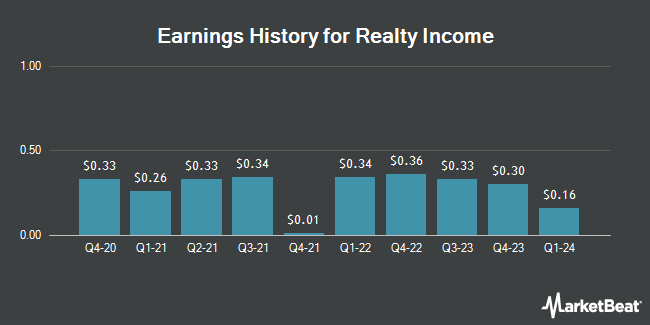Realty Income (NYSE:O - Get Free Report) is expected to be announcing its earnings results after the market closes on Monday, February 24th. Analysts expect the company to announce earnings of $1.06 per share and revenue of $1.28 billion for the quarter. Individual interested in listening to the company's earnings conference call can do so using this link.
Realty Income Trading Up 1.5 %
O stock traded up $0.84 during midday trading on Thursday, hitting $56.51. 5,210,463 shares of the company's stock were exchanged, compared to its average volume of 4,614,123. Realty Income has a one year low of $50.65 and a one year high of $64.88. The stock's fifty day moving average price is $53.85 and its 200-day moving average price is $58.10. The company has a market cap of $49.46 billion, a PE ratio of 53.82, a price-to-earnings-growth ratio of 1.98 and a beta of 1.00. The company has a debt-to-equity ratio of 0.68, a quick ratio of 1.40 and a current ratio of 1.40.
Realty Income Increases Dividend
The firm also recently disclosed a mar 25 dividend, which will be paid on Friday, March 14th. Investors of record on Monday, March 3rd will be given a $0.268 dividend. The ex-dividend date is Monday, March 3rd. This is a positive change from Realty Income's previous mar 25 dividend of $0.26. This represents a dividend yield of 5.7%. Realty Income's payout ratio is currently 301.91%.
Analyst Upgrades and Downgrades
O has been the topic of a number of research reports. Deutsche Bank Aktiengesellschaft assumed coverage on shares of Realty Income in a research note on Wednesday, December 11th. They issued a "hold" rating and a $62.00 price target on the stock. UBS Group reduced their target price on shares of Realty Income from $72.00 to $71.00 and set a "buy" rating for the company in a research note on Thursday, November 14th. Mizuho cut their price objective on shares of Realty Income from $60.00 to $54.00 and set a "neutral" rating on the stock in a research report on Wednesday, January 8th. Scotiabank lowered their target price on Realty Income from $61.00 to $59.00 and set a "sector perform" rating on the stock in a research report on Thursday, January 16th. Finally, Barclays reduced their price target on Realty Income from $59.00 to $56.00 and set an "equal weight" rating for the company in a research report on Tuesday, February 4th. Ten research analysts have rated the stock with a hold rating and three have assigned a buy rating to the company. Based on data from MarketBeat, Realty Income presently has an average rating of "Hold" and a consensus target price of $62.21.
Read Our Latest Stock Report on Realty Income
Realty Income Company Profile
(
Get Free Report)
Realty Income, The Monthly Dividend Company, is an S&P 500 company and member of the S&P 500 Dividend Aristocrats index. We invest in people and places to deliver dependable monthly dividends that increase over time. The company is structured as a real estate investment trust ("REIT"), and its monthly dividends are supported by the cash flow from over 15,450 real estate properties (including properties acquired in the Spirit merger in January 2024) primarily owned under long-term net lease agreements with commercial clients.
See Also

Before you consider Realty Income, you'll want to hear this.
MarketBeat keeps track of Wall Street's top-rated and best performing research analysts and the stocks they recommend to their clients on a daily basis. MarketBeat has identified the five stocks that top analysts are quietly whispering to their clients to buy now before the broader market catches on... and Realty Income wasn't on the list.
While Realty Income currently has a "Hold" rating among analysts, top-rated analysts believe these five stocks are better buys.
View The Five Stocks Here
Discover the 10 Best High-Yield Dividend Stocks for 2025 and secure reliable income in uncertain markets. Download the report now to identify top dividend payers and avoid common yield traps.
Get This Free Report
Like this article? Share it with a colleague.
Link copied to clipboard.